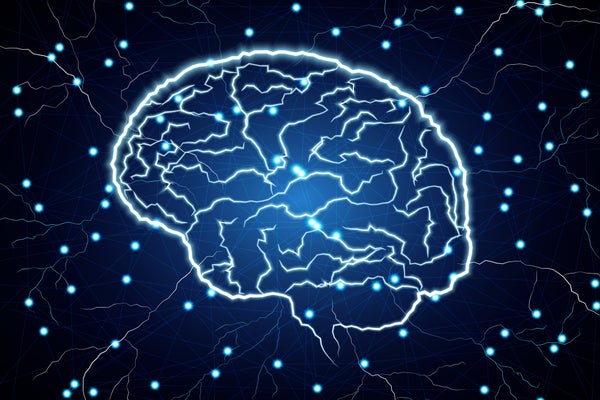Noninvasive brain stimulation is having its heyday, as scientists and hobbyists alike look for ways to change the activity of neurons without cutting into the brain and implanting electrodes. One popular set of techniques, called transcranial electrical stimulation (TES), delivers electrical current via electrodes stuck to the scalp, typically above the target brain area. In recent years a number of studies have attributed wide-ranging benefits to TES including enhancing memory, improving math skills, alleviating depression and even speeding recovery from stroke. Such results have also spawned a cottage industry providing commercial TES kits for DIY brain hackers seeking to boost their mind power.
But little is known about how TES actually interacts with the brain, and some studies have raised serious doubts about the effectiveness of these techniques. A study published on February 2 in Nature Communications ups the ante, reporting that conventional TES techniques do not deliver enough current to activate brain circuits or modulate brain rhythms. The electrical currents mostly fizzle out as they pass through the scalp and skull. “Anybody who has published a positive effect in this field is probably not going to like our paper,” says György Buzsáki, a neuroscientist at New York University School of Medicine and a senior author of the study.
The mechanisms behind TES have remained mysterious, in part because without penetrating the skull, researchers cannot measure neural responses while they apply stimulation. Conventional TES methods produce electrical noise that swamps any brain activity detected on the scalp.
On supporting science journalism
If you're enjoying this article, consider supporting our award-winning journalism by subscribing. By purchasing a subscription you are helping to ensure the future of impactful stories about the discoveries and ideas shaping our world today.
To get around this problem, Buzsáki’s team first implanted electrodes inside the brains of rats and measured neural activity while they applied TES externally. By varying the stimulation parameters, they found the minimum electric field strength needed to trigger neuronal firing or to alter brain rhythms.
Next, the researchers wanted to figure out how much current they needed to apply to the human scalp to produce those electrical fields inside the brain. But these invasive experiments cannot be done in people, so Buzsáki’s team went with the next best thing: human cadavers. By implanting recording electrodes inside the cadavers’ brains and applying TES externally, the researchers found that they needed to zap the scalp with about 4 to 6 milliamperes of current—well above typical current levels.
Normally, TES practitioners avoid currents above 2 mA, because these induce side effects such as tingling, dizziness, unpleasant tastes, and illusory sights and sounds—the result of current entering soft tissues such as the eyes, ears and facial nerves, which offer less resistance than the skull. In fact, in both rats and human cadavers, Buzsáki’s team found about 75 percent of currents applied to the scalp never reach the brain, but instead are taken up by the skull, scalp and other external tissues.
The findings resonate with skeptics of these techniques including Jared Horvath, a neuroscientist at the University of Melbourne in Australia. In a 2015 meta-analysis Horvath rounded up about 400 publications that applied tDCS—(a version of TES that uses direct current) and reportedly influenced some aspect of cognition or behavior. When he pooled studies, his team found that although individual papers reported certain benefits (such as reduced reaction time or increased accuracy on a task), no reliable effects could be identified across studies. “Now, finally, we have hard data showing what many people have suspected all along: that tDCS simply is not getting into the brain,” Horvath says.
To deliver the higher currents needed to get the job done, Antal Berényi, senior author on the new study and a neuroscientist at the University of Szeged in Hungary, developed a new TES system. Instead of using only one pair of stimulating electrodes, the design splits the work among six electrode pairs that each deliver a fraction of the desired current in rapid pulses that overlap and add up inside their target neurons. Tests in healthy volunteers showed this setup reduced the side effects associated with delivering higher currents. With more refinement and even more electrodes, Buzsáki hopes they can eventually eliminate the unwanted sensations.
Some researchers aren’t ready to give up on traditional TES. Buzsáki’s team found conventional protocols lack sufficient current to directly influence brain circuits, but their study focused on what happened immediately following stimulating pulses. “Most TES approaches apply stimulation for tens of minutes,” notes Marom Bikson, a biomedical engineer at The City College of New York who was not involved with the study. Bikson suggests current TES practices could still exert subtle effects on neurons that accumulate over time to modulate brain function.
Buzsáki acknowledges there are many possible routes by which conventional TES could alter neural activity indirectly or over longer time scales. One obvious candidate is the placebo effect—people improve because they believe the treatment works. But there may also be other explanations: Stimulating nerves on the scalp could send signals back to the brain or influence circulation. Or other types of cells besides neurons might pick up electrical fields and gradually alter brain function. Hard evidence, however, is lacking to prove most of these theories, Buzsáki notes. “I think the game now is to throw the ball back to those who claim there are positive effects and have them explain, if necessary, how it happens,” he says.
